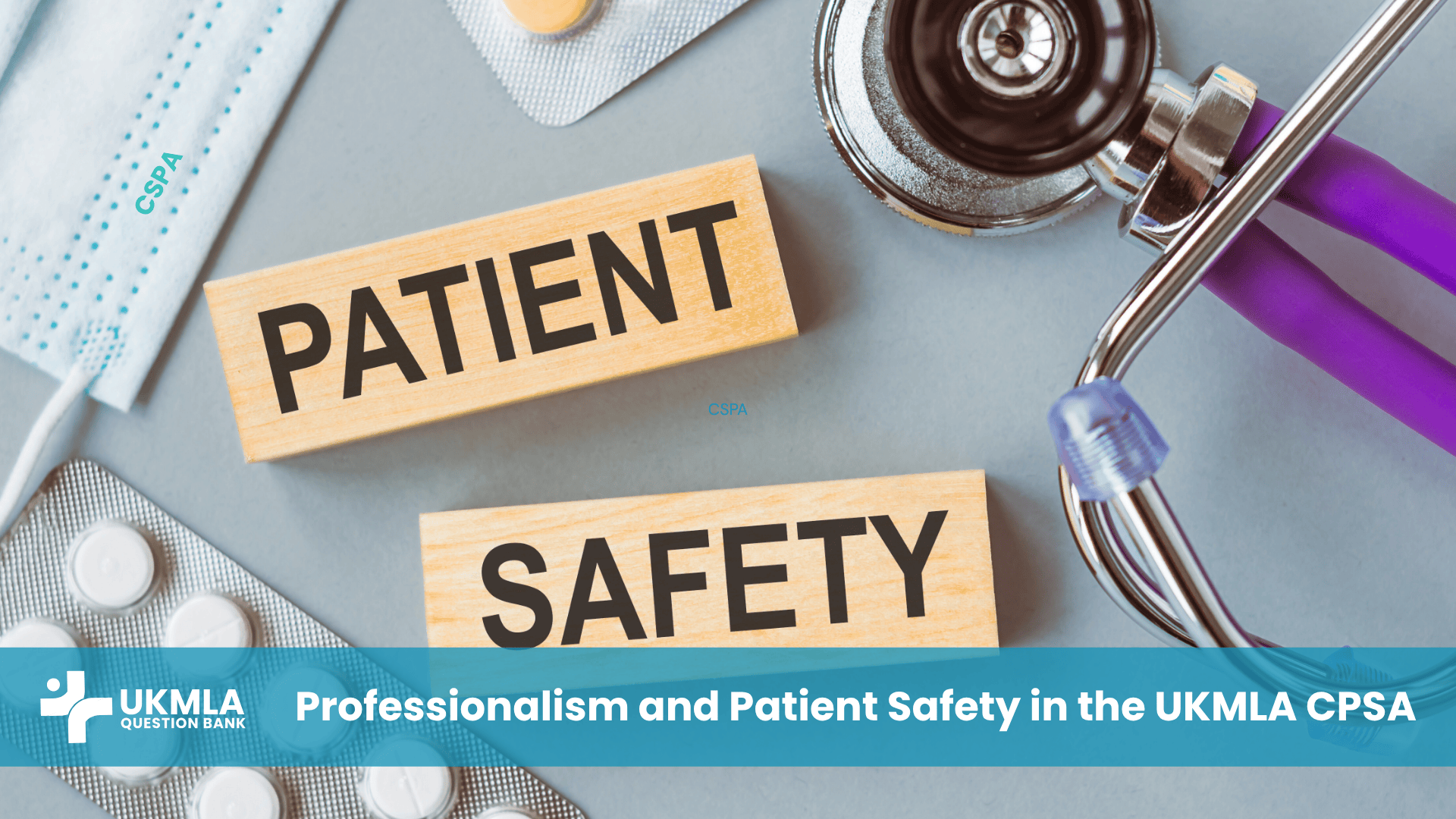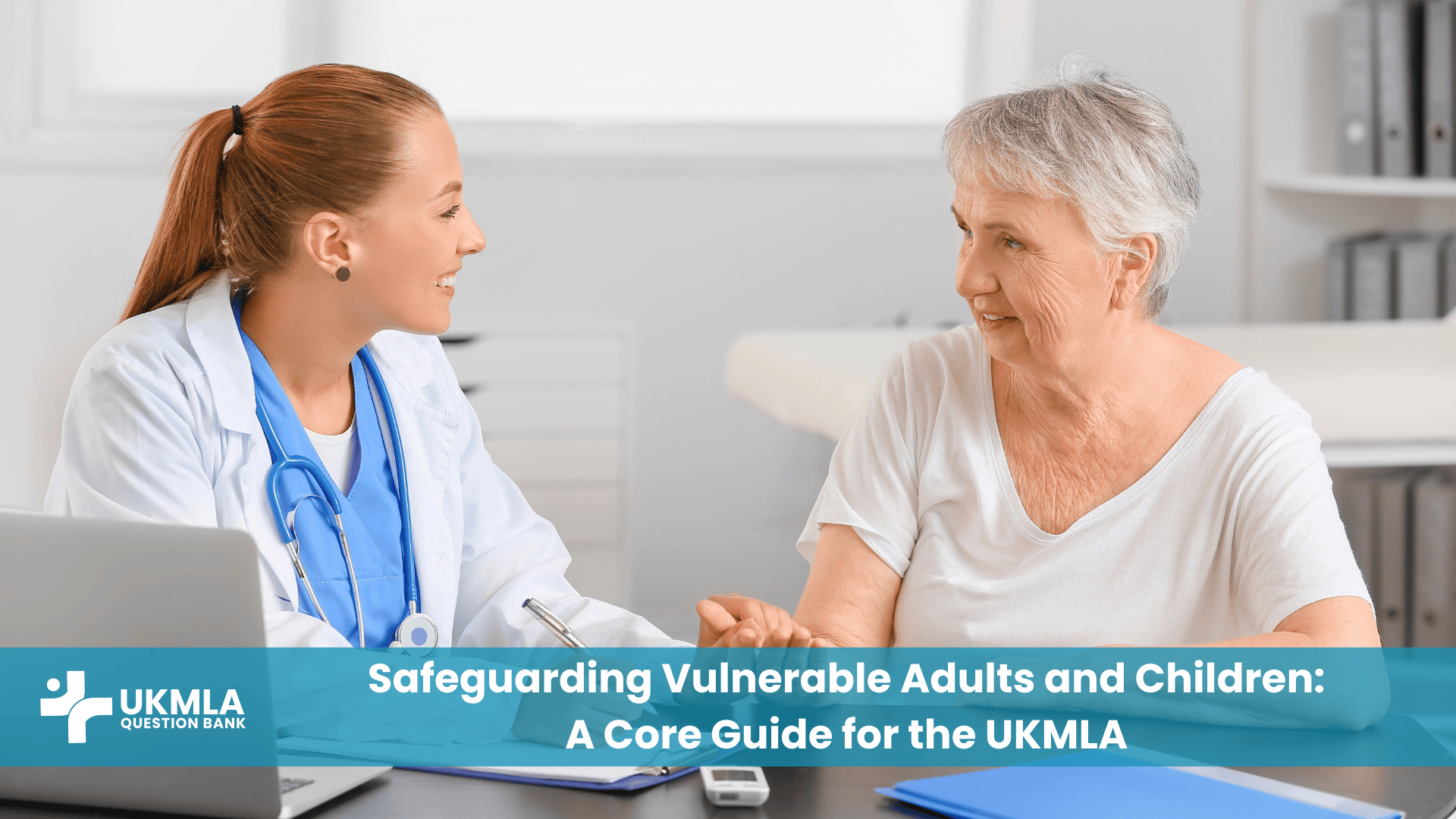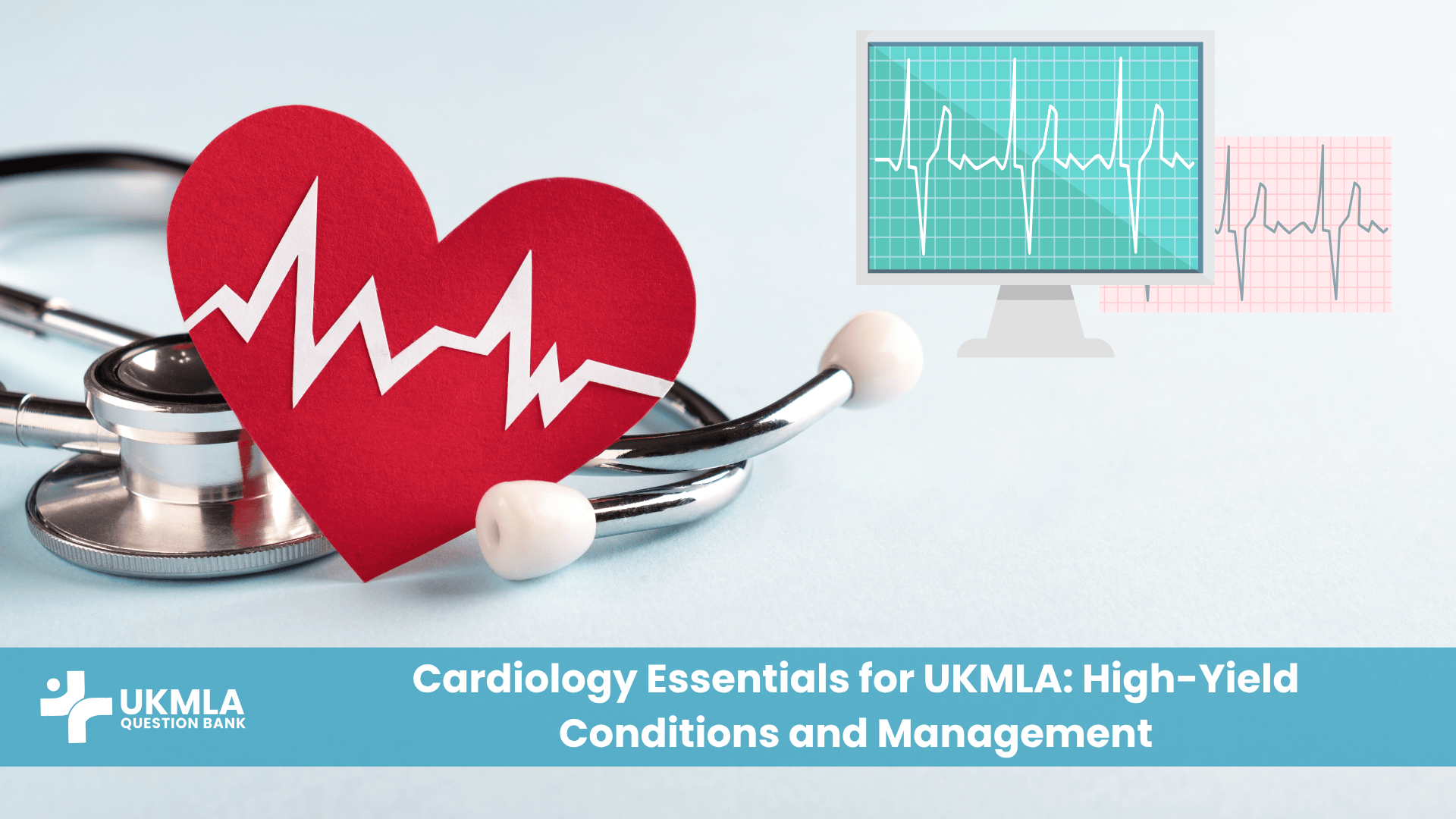In the high-pressure environment of the UKMLA Clinical and Professional Skills Assessment (CPSA), it’s easy to focus on demonstrating your clinical knowledge and procedural skills. However, underpinning every single station is a silent, continuous assessment of two even more critical domains: professionalism and patient safety. These are not specific stations you can rehearse; they are the very fabric of the entire exam. Mastering UKMLA professionalism and patient safety is what truly distinguishes a competent candidate from an exceptional one, proving you are ready for the responsibilities of a UK doctor.
This guide provides a practical, comprehensive framework for understanding and demonstrating the core tenets of UKMLA professionalism and patient safety. We will explore how these “invisible” competencies are scored in every encounter, from the initial introduction to handling challenging ethical dilemmas. We will break down the crucial actions that signal to an examiner that you are a safe, respectful, and reliable future colleague. By integrating these principles into every aspect of your practice, you can ensure you are showcasing your best professional self throughout the CPSA.
Key Takeaways
Before we dissect the details, here are the core principles for demonstrating excellence in UKMLA professionalism and patient safety:
- Safety is Active, Not Passive: Patient safety isn’t just about avoiding harm; it’s about actively taking steps to ensure it, like confirming patient ID, checking for allergies, and gaining informed consent.
- Professionalism is Assessed Continuously: From your attire and introduction to how you handle a mistake, every action is being evaluated against the standards of a UK junior doctor.
- The ‘WIPE’ Introduction is a Safety-Critical Step: Washing hands, Introducing yourself, gaining Permission, and ensuring appropriate Exposure are non-negotiable marks in every station.
- Communication is a Safety Tool: Clear, empathetic communication prevents errors, manages patient anxiety, and is a cornerstone of professional practice.
- Know Your Limits and Escalate: A key aspect of UKMLA professionalism and patient safety is recognizing when a situation is beyond your competence and knowing how and when to call for senior help.
- Respect Patient Dignity: Always be mindful of patient comfort, privacy, and autonomy. This includes appropriate draping during examinations and using respectful language.
- Honesty is Paramount: If you make a mistake or don’t know something, be open and honest. Attempting to hide an error is a major professional red flag.
The GMC’s “Good Medical Practice”: Your Assessment Blueprint
The entire CPSA is a practical application of the principles laid out in the General Medical Council’s core guidance, “Good Medical Practice“. Understanding its four domains gives you a “behind the scenes” look at the assessment criteria.
Domain 1: Knowledge, Skills, and Performance
This domain is about more than just recalling facts. In the CPSA, it’s about applying your knowledge effectively. Examiners are looking to see that you provide a good standard of clinical care. This means applying your medical knowledge to the situation, recognizing and working within the limits of your competence, and keeping your skills up to date.
In a station, this is demonstrated by your ability to form a reasonable differential diagnosis after taking a history, or by suggesting appropriate initial investigations. It’s also shown when you correctly identify a need for senior input, proving you understand the boundaries of your role as a junior doctor. Excellent performance in this domain requires a solid knowledge base, which can be honed by using resources like a “UKMLA Question Bank: An Essential Resource for Medical Aspirants“.
Domain 2: Safety and Quality
This is arguably the most important domain in the CPSA. It encompasses all aspects of UKMLA professionalism and patient safety. You must take prompt action if you think patient safety is being compromised. This includes contributing to and complying with systems to protect patients, which translates to simple actions like hand hygiene, checking patient details, and confirming drug allergies. It also means responding to risks. If a patient tells you they feel dizzy, your immediate response should be to ensure they are safe from falling. This domain is tested in every single second of every patient-facing station.
Domain 3: Communication, Partnership, and Teamwork
This domain focuses on your interpersonal skills. You must communicate effectively with patients, listen to their concerns, and respond to their needs. This involves exploring their ideas, concerns, and expectations (ICE). It also means working collaboratively with colleagues. In a station involving a simulated nurse or another healthcare professional, your ability to communicate respectfully and clearly, and to value their input, is being directly assessed. Teamwork is a cornerstone of the NHS, and demonstrating your ability to be a good team player is essential. Our guide on “History Taking in the UKMLA CPSA: What Examiners Look For” provides many practical examples of this domain in action.
Domain 4: Maintaining Trust
This domain is about honesty, integrity, and treating patients with respect. It means being open and honest if something goes wrong (candour), respecting patient confidentiality, and never abusing your position as a doctor. In a CPSA station, this is demonstrated by your professional demeanour, your respect for patient dignity during an examination, and your honest handling of difficult questions or ethical dilemmas. Any action that could be perceived as dishonest or disrespectful will result in a very poor score in this domain
| GMP Domain | How It’s Assessed in the CPSA | Example Action |
|---|---|---|
| Knowledge, Skills & Performance | Your ability to apply knowledge and recognize your limits. | Suggesting a sensible differential diagnosis and stating you would discuss with a senior. |
| Safety & Quality | Your active steps to prevent harm and respond to risks. | Visibly washing your hands and checking the patient’s name and date of birth. |
| Communication & Teamwork | How you interact with patients and colleagues. | Asking about the patient’s concerns (ICE) and using a structured SBAR handover. |
| Maintaining Trust | Your honesty, integrity, and respect for patients. | Respectfully explaining a procedure and gaining full, informed consent before proceeding. |
Core Safety Behaviours for Every CPSA Station
These are the non-negotiable actions that demonstrate a commitment to UKMLA professionalism and patient safety. They should be embedded in your practice for every single station.
The ‘WIPE’ Introduction: A Critical Safety Procedure
We cannot overstate the importance of this. The WIPE sequence (Wash hands, Introduce, Permission, Exposure) is your first and best opportunity to demonstrate you are a safe practitioner.
- Wash Hands: This is the single most important infection control measure. Do it visibly with alcohol gel as you enter.
- Introduce Yourself: Clearly state your name and role. This builds trust and clarifies the professional relationship.
- Permission & Patient ID: This is a critical safety checkpoint. Confirm the patient’s name and date of birth against their wristband. Then, explain what you plan to do in simple terms and gain their explicit consent. This is fundamental to respecting patient autonomy.
- Exposure & Positioning: Position the patient appropriately for the task, ensuring their comfort. Only expose what is necessary and use drapes or blankets to maintain their dignity.
Informed Consent: A Dialogue, Not a Question
Gaining informed consent is more than asking “Is that okay?”. It’s a brief but crucial dialogue. You must ensure the patient understands what you are about to do. For example: “I need to examine your breathing, which will involve listening to your chest with my stethoscope. This will require you to sit forward and take some deep breaths. Are you happy for me to proceed?” This demonstrates a much deeper understanding of consent than a simple one-line question.
Escalation and Teamwork: Knowing When to Call for Help
A key aspect of safe practice is recognizing the limits of your own competence. The examiners are not expecting you to manage every situation alone; they are expecting you to know when to ask for help.
- Verbalize Escalation: In any scenario involving a deteriorating patient or a complex problem, you should explicitly state, “At this point, I would urgently bleep my senior registrar for assistance.”
- Use Structured Communication: When you do escalate, demonstrate how you would do it safely. Use a structured handover tool like SBAR (Situation, Background, Assessment, Recommendation). For example: “Hello, this is Dr. Smith, the FY1 on Ward 10. (S) I’m calling about Mr. Jones in bed 5. He has become acutely breathless and hypotensive. (B) He is a 72-year-old man admitted with pneumonia. (A) His respiratory rate is 30, sats are 88% on air, and his BP is 85/50. I think he is developing septic shock. (R) I am starting the Sepsis Six pathway, but I need you to review him urgently.” This clear communication is a vital patient safety tool.
Navigating Challenging Professional and Ethical Scenarios
The CPSA will likely include stations specifically designed to test your professionalism and ethical reasoning under pressure.
Dealing with an Angry or Upset Patient
This is a classic test of your communication skills and a core element of UKMLA professionalism and patient safety.
- Stay Calm and Do Not Get Defensive: Your first job is to de-escalate the situation.
- Acknowledge Their Emotion: Start by validating their feelings. “I can see that you are very angry, and I want to understand why.”
- Use Active Listening: Let them talk without interruption. Use open questions like, “Can you tell me more about what has happened?”
- Empathize and Apologize (Where Appropriate): Show empathy for their situation. An apology is not an admission of liability; saying “I am very sorry that you have had this difficult experience” is a powerful way to build rapport.
- Focus on a Solution: Once you understand the problem, work with them to find a way forward. “Let’s figure out together what we can do to address this now.”
Managing a Colleague’s Mistake
You might be put in a scenario where you discover a mistake made by a colleague (e.g., a wrong drug prescribed).
- Patient Safety First: Your immediate priority is the patient. Take action to mitigate any harm.
- Be Honest and Factual: You must be open with the patient (candour), but do not blame your colleague. State the facts clearly: “It appears that you were given a different medication from the one intended. We need to monitor you closely…”
- Address it Professionally: You have a professional duty to address the issue with the colleague involved in a sensitive and supportive manner, and to ensure the incident is reported through official channels (e.g., an incident form) so that systems can be improved.
Confidentiality and Capacity
Ethical principles are frequently tested.
- Confidentiality: Be prepared for a scenario where a relative asks for information about a patient. You must politely but firmly explain that you cannot share confidential information without the patient’s explicit consent.
- Capacity: You may have to assess a patient’s capacity to make a decision. Remember the four key points: can the patient understand the information, retain it, weigh it up to make a choice, and communicate their decision? If a patient lacks capacity, you must act in their best interests, involving family and senior colleagues where appropriate.
| Challenging Scenario | Key Professional Principle | Safe Action to Demonstrate |
|---|---|---|
| An Angry Relative | De-escalation and Empathy | Acknowledge their anger, listen to their concerns without interruption, and focus on the patient’s care. |
| A Patient Lacking Capacity to Consent | Acting in the Patient’s Best Interests | Assess capacity formally. If they lack capacity, state you would proceed based on what is in their best interest, involving family and seniors. |
| Discovering a Drug Error | Patient Safety and Professional Candour | Immediately inform the patient and your senior. Ensure patient safety, and explain that an incident report will be filed to learn from the error. |
Common Pitfalls and How to Avoid Them
Being aware of common mistakes can help you steer clear of them on exam day.
Highlight: The single biggest failure of professionalism is a lack of insight. This can be demonstrated by blaming others, being dismissive of patient concerns, or failing to recognize the seriousness of a situation.
| Pitfall | Why It’s a Problem | How to Avoid It |
|---|---|---|
| Forgetting to Check for Allergies | A critical patient safety failure. Giving a drug to an allergic patient can be fatal. | Make asking about allergies a mandatory part of every drug history and before administering any medication. |
| Using Medical Jargon | This creates a barrier with the patient and demonstrates poor communication skills. | Practice explaining common conditions and procedures in simple, everyday language. |
| Performing a ‘Slick’ but Impersonal Examination | Rushing can cause you to miss crucial signs and make the patient feel like an object, not a person. | Practice your routine so it is efficient, not rushed. Always check for patient comfort during the examination. |
| Trying to Hide a Mistake | Lack of insight and honesty is a grave professional concern. It is far worse than the initial mistake. | If you make a small error (e.g., forget a step), acknowledge it calmly (“I’d just like to go back and check…”). If you realize a more significant error, state what you would do to rectify it. |
Frequently Asked Questions (FAQ) Your Professionalism and Patient Safety Questions Answered
Yes, you could have a station that is specifically designed around an ethical dilemma or a conversation with a distressed relative. However, UKMLA professionalism and patient safety are assessed in every single station, not just dedicated ones.
Acknowledge it calmly and professionally. For a minor procedural step, you can say, “Apologies, I would just like to go back and…” For a more significant error, you might need to say at the end, “On reflection, I realize I should have done X. I would ensure to rectify this and document it.” Honesty is key.
Genuine empathy comes from active listening. Instead of just waiting for your turn to speak, truly listen to the patient’s words and concerns. Your response will then be a natural reflection of what you’ve heard, rather than a pre-scripted line. Practice helps this feel more natural.
This depends on the context and cultural sensitivity. A light, brief touch on the forearm can be a powerful sign of empathy, but you must be attuned to the patient’s non-verbal cues. If in any doubt, it is safer to rely on your words and tone of voice.
You must respect their autonomy. This is a classic test of UKMLA professionalism and patient safety. Do not proceed. Instead, explore their reasons. Say, “Of course, I won’t do anything you’re not comfortable with. Could you help me understand your concerns?”
Practice using a simple ethical framework (e.g., the four pillars: autonomy, beneficence, non-maleficence, justice). Discuss common scenarios with peers, such as consent for a confused patient or dealing with a colleague’s mistake.
Yes. You should always state that you would clean your equipment (stethoscope, etc.) before and after patient contact. This is a core infection control principle and a key part of patient safety.
You must verbalize your safety-conscious thoughts. For example, “Before prescribing this medication, I would want to check the patient’s renal function and any known allergies.” This demonstrates your thought process.
You should not disagree with the premise of the station. Your task is to perform the role assigned to you as a safe and competent FY1 doctor within the given scenario. If a task seems unsafe, your role is to explain why and what you would do instead (e.g., “The instructions ask me to give this drug, but given the patient’s allergy, I would not do this and would instead speak to my senior”).
Make it a part of your daily life and clinical experience. Treat every real patient with the same level of respect, dignity, and care that you would in a CPSA station. Read our guide on “Integrating Clinical Experience with UKMLA Book Study” to learn how to make the most of these opportunities.
Conclusion: The Heart of Being a Good Doctor
Ultimately, UKMLA professionalism and patient safety are not just exam domains; they are the very essence of what it means to be a good doctor. The CPSA is your platform to show that you embody these values. By embedding the principles of safety, respect, empathy, and honesty into your every action, you demonstrate a level of competence that goes far beyond textbook knowledge.
Prepare by practicing not just the “what” but the “how.” Rehearse your introductions, consider your language, and think about the patient’s perspective in every scenario. A candidate who is professional and safe is a candidate who has proven they are ready to be entrusted with the care of patients, and that is the true goal of the UKMLA.



